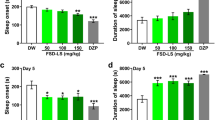Abstract
Although both MK-801 (dizocilpine: 0.1 mg/kg, IP) and ethanol (1.6 nd 2.4 g/kg, PO) only slightly increased ambulatory activity in mice, their combination produced a marked enhancement of the ambulation-increasing effect. The combination of MK-801 (0.03 mg/kg) with ethanol (1.6 and 2.4 g/kg) also elicited a significant increase in the mouse's ambulation. A significant enhancement of the effect was produced by the combination of ketamine (3 and 10 mg/kg) with ethanol only (2.4 g/kg). The ambulation increment induced by the combination of MK-801 (0.1 mg/kg) plus ethanol (1.6 g/kg) was dose-dependently inhibited by YM-09151-2 (0.0001–0.01 mg/kg IP), SCH 23390 (0.001–1 mg/kg IP), reserpine (0.1–1 mg/kg, IP) and ceruletide (0.00001–0.001 mg/kg, IP), and the highest dose of each drug was effective for complete inhibition of the ambulation. Naloxone (0.05–5 mg/kg IP), apomorphine (0.001–0.1 mg/kg IP) and α-methyl-p-tyrosine (50–200 mg/kg, IP) partially reduced the ambulatory activity induced by the combination of MK-801 with ethanol. These results suggest that the dopaminergic system, particularly via presynaptic changes in the release of stored dopamine, as well as the opioid system, are involved in the interaction of MK-801 with ethanol.
Similar content being viewed by others
References
Akiyoshi T, Matsushita A, Ikeda M, Kihara T, Matsubara K (1990a) Different effects of ceruletide on dopaminergic system in the striatum and the nucleus accumbens of the rat (I). Studies on dopamine release by in vivo microdialysis. In: Sofue I (ed) Neuropeptide: basic and clinical. Japanese Ministry of Welfair and Public Health, Tokyo, pp 269–277 (abstract in English)
Akiyoshi T, Matsushita A, Matsubara K, Ikeda M, Kihara T (1990b) Different effects of ceruletide on dopaminergic system in the striatum and the nucleus accumbens of the rat (iII). Studies on dopaminergic function by circling behavior. In: Sofue I (ed) Neuropeptide: basic and clinical. Japanese Ministry of Welfair and Public Health, Tokyo, pp 278–283 (abstract in English)
Altar CA, Boyar WC, Oei E, Wood PL (1988) Cholecystokinin attenuates basal and drug-induced increases of limbic and striatal dopamine release. Brain Res 460:76–82
Anden NE, Rubenson A, Fuxe K, Hokfelt T (1967) Evidence for dopaminergic receptor stimulation by apomorphine. J Pharm Pharmacol 9:627–629
Carlsson M, Svensson A (1990) Interfering with glutamatergic neurotransmission by means of NMDA antagonist administration discloses the locomotor stimulatory potential of other transmitter systems. Pharmacol Biochem Behav 36:45–50
Clineschmidt BV, Martin GE, Bunting PR, Papp NL (1982) Central sympathomimetic activity of (+)-5-methyl-10,11-dihydro-5H-dibenzo-[a,d]-cyclohepten-5,10-imine (MK-801), a substance with potent anticonvulsant, central sympathomimetic, and apparent anxiolytic properties. Drug Dev Res 2:135–145
Ida I, Asami T, Kuribara H, Machiyama Y, Tadokoro S (1990) Characteristics of antagonism between ceruletide and various central-acting drugs: investigation by means of ambulatory activity in mice. Folia Pharmacol Japon 96:333–341 (abstract in English)
Imperato A, Di Chiara G (1986) Preferential stimulation of dopamine release in the nucleus accumbens of freely moving rats by ethanol. J Pharmacol Exp Ther 239:219–238
Iversen SD, Singh L, Oles RJ, Preston C, Tricklebank MD (1988) Psychopharmacological profile of theN-methy-d-aspartate (NMDA) receptor antagonist, MK-801. In: Domino EF, Kemenk J-M (eds) Sigma and phencyclidine-like compounds as molecular problems in biology. NPP Books, Ann Arbor, pp 373–382
Kuribara H, Tadokoro S (1986) Behavioral interaction between methamphetamine and ethanol by means of ambulatory activity in mice. Jpn J Alcohol Drug Depend 21:154–163
Kuribara H, Asahi T, Tadokoro S (1991) Enhancement of the ambulation-increasing effect of opioid analgesics by ethanol in mice. Jpn J Pharmacol 56:457–463
Kuribara H, Asami T, Ida I, Tadokoro S (1992a) Characteristics of the ambulation-increasing effect of the noncompetitive NMDA antagonist MK-801 in mice: assessment by the coadministration with central-acting drugs. Jpn J Pharmacol 58:11–18
Kuribara H, Asahi T, Tadokoro S (1992b) Ethanol enhances, but diazepam and pentobarbital reduce the ambulation-increasing effect of caffeine in mice. Jpn J Alcohol Drug Depend 27:528–539
Liljequist S (1991) Genetic differences in the effects of competitive and non-competitive NMDA antagonists on locomotor activity in mice. Psychopharmacology 104:17–21
Mason ST (1984) Catecholamines and behavior. Cambridge University Press, Cambridge
Matsumoto T, Nakahara T, Uchimura H, Hirano M, Yokoo H, Nakamura K, Oomagari K (1984) Effect of systemically administered caerulein on dopamine metabolism in rats brain. Brain Res 324:195–199
Morelli M, Fenu S, Pinna A, Di Chiara G (1992) Opposite effects of NMDA receptor blockade on dopaminergic D1- and D2-mediated behavior in the 6-hydroxydopamine model of turning: relationship with c-fos expression. J Pharmacol Exp ther 260:402–408
Snell LD, Yi S-J, Johnson KM (1988) Comparison of the effects of MK-801 and phencyclidine on catecholamine uptake and NMDA-induced norepinephrine release. Eur J Pharmacol 145:223–226
Tricklebank MD, Singh L, Oles RJ, Preston C, Iversen SD (1989) The behavioural effects of MK-801: a comparison with antagonists acting non-competitively and competitively at the NMDA receptor. Eur J Pharmacol 167:127–135
Uchihashi Y, Kuribara H, Tadokoro S (1992) Assessment of the ambulation-increasing effect of ketamine by coadministration with central-acting drugs in mice. Jpn J Pharmacol 60:25–31
Widerlov E, Kalivas PW, Lewis MH, Prange Jr AJ, Breese GR (1983) Influence of cholecystokinin on central monoaminergic pathways. Regul Pept 6:99–109
Author information
Authors and Affiliations
Rights and permissions
About this article
Cite this article
Kuribara, H. Potentiation of the Ambulation-increasing effect induced by combined administration of MK-801 with ethanol in mice. Psychopharmacology 113, 453–456 (1994). https://doi.org/10.1007/BF02245222
Received:
Revised:
Issue Date:
DOI: https://doi.org/10.1007/BF02245222




